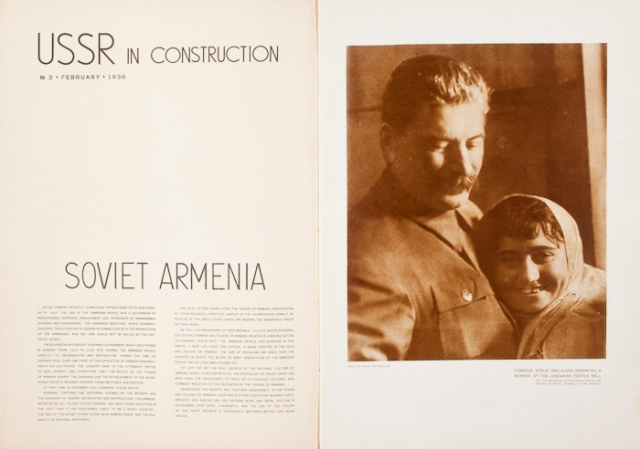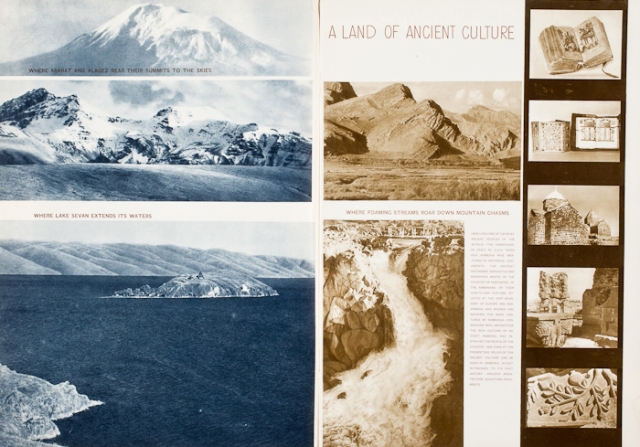
USSR in Construction, photo by Kislov (Soyuzphoto), February 1936, No. 2, (2012.13.30)
Comrade Stalin and Elena Abramyan, a worker at the Leninakan [Gyumri] Textile mill. (At the reception of the delegation of the toilers of Soviet Armenia in the Kremlin.)
Soviet Armenia
Soviet Armenia recently completed fifteen years of its existence up to 1920, the life of the Armenian people was a succession of indescribable suffering, enslavement and oppression by innumerable invaders and conquerors. The “Armenian Question,” which formerly occupied the attention of Europe in connection with the persecution of the Armenians, was not and could not be solved by the capitalist world.
The bourgeois nationalist “Dashnak” government which held power in Armenia from 1918 to 1920 was leading the Armenian people directly to degeneration and destruction During the time of Dashnak rule, over one-third of the population of Armenia perished – about 480,00 people. The country sank to the uttermost depths of ruin, poverty and starvation. Only the revolt of the toilers of Armenia against the Dashaks and the establishment of the Soviet power saved a splendid country from inevitable destruction.
At that time, in December 1920, comrade Stalin wrote: “Armenia, tortured and suffering, doomed by the entente and the Dashnaks to hunger, devastation and depopulation, this Armenia, betrayed by all its self-styled friends, has now found salvation in the fact that it has proclaimed itself to be a soviet country… the idea of the Soviet power alone gave Armenia peace and the possibility of national recovery.”
And now fifteen years later, the toilers of Armenia, participating by their peaceful creative labor in the harmonious family of peoples of the great Soviet Union, are reaping the wonderful fruits of their work.
On the 15th anniversary of their Republic, 150,00 shock workers, collective farmers and toilers of Armenia related a moving letter to comrade Stalin what the Armenian people had achieved in this period. A new life, happy and joyous, is being created in the hills and valleys of Armenia. The sun of Socialism has risen over the country in which the blood of many generations of the Armenian people had so long been poured out.
“At last we see the real growth of the national culture of Armenia, which together with all the peoples of the Soviet Union, has been given the opportunity to build up its Socialist culture,” said comrade Molotov to the delegates of the toilers of Armenia.
Henceforth this growth will continue unceasingly. In the towns and villages of Armenia, ever new electric lights are blazing forth. Industry and agriculture are growing more and more, culture is blossoming ever more luxuriantly, and the life of the toilers of the happy Republic is continually becoming better and more joyous. USSR in Construction, February 1936, No. 2, (2012.13.30)

USSR in Construction, February 1936, No. 2, (2012.13.30)
Where Ararat and Alagez rear their summits to the skies.
Where Lake Sevan extends its waters.
Where foaming streams roar down mountain chasms.A Land of Ancient Culture
Here lives one of the most ancient peoples of the world – the Armenian. As early as 2,500 years ago, Armenia was mentioned in historical documents. The ancient historians Herodotus and Xenohon wrote of the country of shepherds, of Armenians, of their habits and customs. Situated at the very boundary of Europe and Asia, Armenia was invaded and ravished for many centuries by numerous conquerors who devastated the rich culture of ancient Armenia and destroyed the people of the country. And even at the present day, relics of this ancient culture can be seen in Armenia, silent witnesses to its past history – ancient architecture, sculpture, documents. USSR in Construction, February 1936, No. 2, (2012.13.30)

USSR in Construction, February 1936, No. 2, (2012.13.30)
In the course of 11 years, the toilers of Armenia have planted 8,000 hectares of new orchards and vineyards. Armenian peaches have earned a worldwide reputation.
Before the Soviet power, the Erivan canning factory was a dirty little workshop with an insignificant output, not exceeding 5000,000 cans a year. This factory, now completely rebuilt, produces 15,000,00 cans every year.

USSR in Construction, February 1936, No. 2, (2012.13.30)
Taking butter from a churn.
The Kalinin cheese factory.
Testing the temperature of cheese.
Finished cheeses.New, well-equipped cheese factories, working by electric power, have been built in the alpine zone of Armenia.

USSR in Construction, February 1936, No. 2, (2012.13.30)
Erivan [Yerevan] – The Capital of Armenia
Armenian towns
Building of the town Soviet in Leninakan [Gyumri].
Street in Leninakan [Gyumri].
Above the street in Erivan [Yerevan].
Views of old Armenia.There was a time when a Persian Sardar ruled with his Ferrashas in this city. After him came a Tsarist governor with his cossacks and later came the Dashnak Khatisov with his gunmen.
In 1918, when the Dashnak government was in power in Erivan, the naked and starving refugees lay in the streets alongside the corpses of animals that had died of starvation.
Soviet Erivan is a progressive, genuinely cultured city, with scores of factories and mills, with blocks of many-storeyed houses, with street cars, water supply, educational institutions, theaters, instead of the former 30,000 inhabitants, it has a population of 140,000 [3,000,000 in 2011].
Erivan is a city without illiterate people, a city of growing culture. It is becoming the foremost Soviet city at the borders of the East.
Several pages from the magazine USSR in Construction, February 1936, No. 2, to commemorate the 101st anniversary of the beginning of the Armenian Genocide.
(A few links: NY Times, NY Times Lens Blog: “Survivors of the Armenian Genocide,” photographer Nazik Armenakyan, The Independent, The Independent, The Armenian Genocide Museum & Institute (AGMI))

USSR in Construction, February 1936, No. 2, (2012.13.30)

